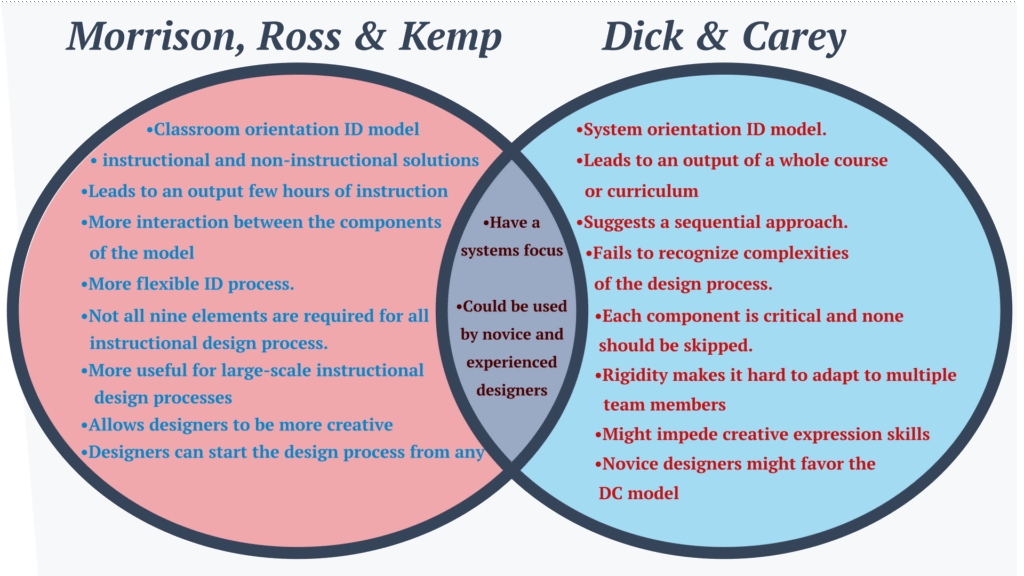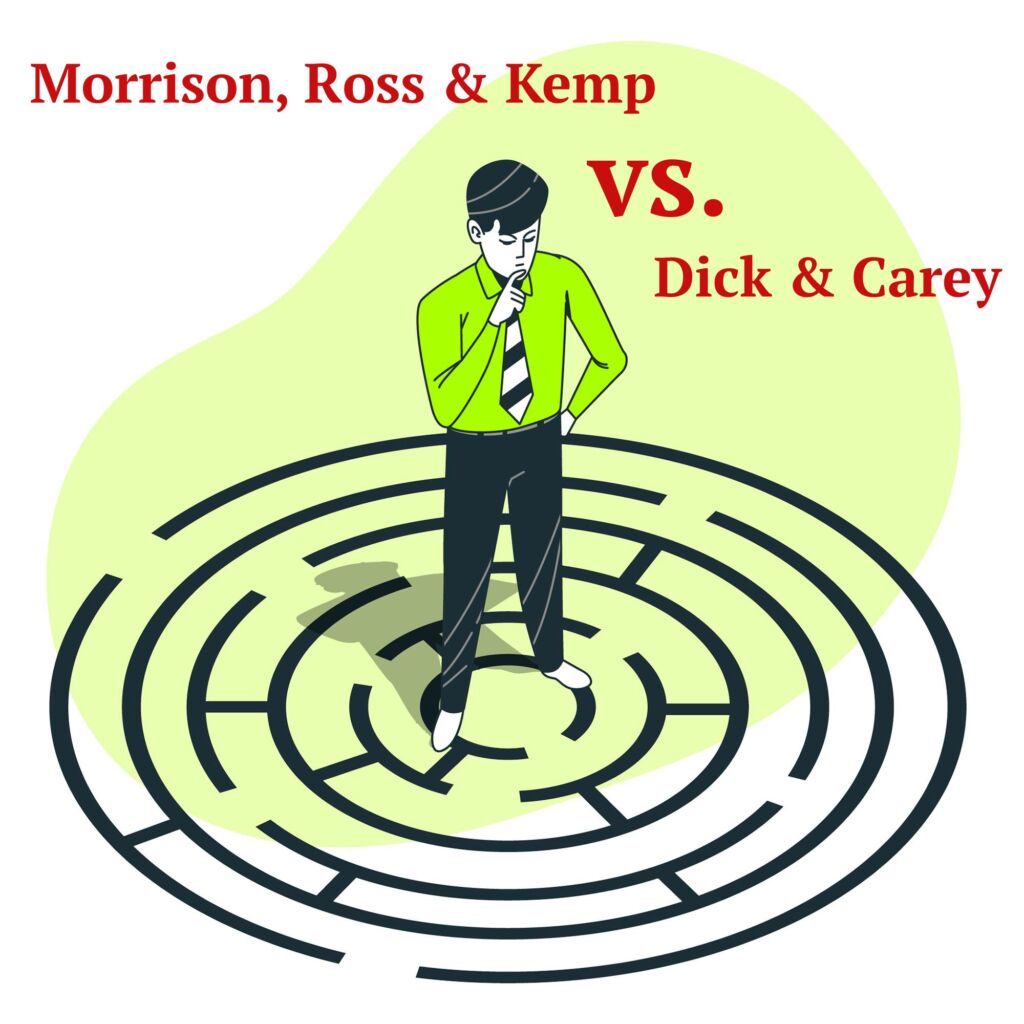The instructional design models, Morrison, Ross & Kemp and Dick and Carey both have applications for different instructional design settings. They both see the instructional design as a means to problem-solving. However, there are also differences between the two models.
If you’re wavering between one of these two popular instructional design models or confused how they differ, this article should help clarify.
Ready to find out which one suits your needs best? Let’s compare the two…
Overview of MORRISON, ROSS AND KEMP MODEL (MRK)
The Morrison, Ross and Kemp model of instructional design consists of nine interrelated steps:

- Identifying instructional design problems and specifying relevant goals
- Examining learner characteristics
- Identifying subject content and analyzing task components that are related to instructional goals
- Stating instructional objectives for the learners
- Sequencing content within each unit to sustain logical learning
- Designing instructional strategies for each learner to master the objectives planning instructional delivery
- Design the messaging and content for the learning
- Selecting resources to support learning activities
- Developing evaluation instruments
The nine elements listed above are interdependent, they are not required to be considered in an orderly way to realize the instructional learning systems design. The MRK model considers instruction from the perspective of the learners, the instructional design process is presented as a continuous cycle.
Other Instructional Design Models:
Overview of DICK AND CAREY MODEL (DC)
The Dick and Carey model follows the instructional design pattern of the analysis, design, development, implementation and evaluation of instruction (ADDIE). It consists of following ten components:

- Assessing needs to identify goals
- Conducting instructional analysis
- Analyzing the learners and contexts
- Writing performance objectives
- Developing assessment instruments
- Developing instructional strategy
- Developing and selecting instructional materials
- Designing and conducting the formative evaluation of instruction
- Revising instruction
- Conducting summative evaluation
It prescribes a sequence where the instruction is broken down into small components. The designers identify skills that should be learned in order for learners to acquire the intended behaviors. Then they select the relevant stimulus to build in each of those skills.
Comparison

- Both models have a systems focus.
- Both models could be used by both novice and experienced designers requiring few or no additional resources to understand the models
Morrison Ross & Kemp
- MRK model as a classroom orientation ID model
- MRK model suggests both instructional and non-instructional solutions
- MRK model leads to an output of one or few hours of instruction
- MRK model is a curvilinear ID model which communicates more interaction between the components of the model.
- MRK model corresponds with a more flexible ID process.
- MRK model claims that not all nine elements are required for all instructional design process.
- MRK model looks more useful for large-scale instructional design processes involving several team members and multiple types of resources.
- MRK Model less prescriptive and allows designers to be more creative in turning design elements into design processes.
- whilst experienced designers might favor the MRK model since it allows more creativity and helps the designers to start the design process from any step the context requires
- MRK model seems to provide more opportunities for creativity and represent the real-life instructional design processes better.
Dick and Carey
- DC model as a system orientation ID model.
- DC model is systems-oriented and leads to an output of a whole course or curriculum
- DC model is a rectilinear ID model which suggests a sequential approach.
- DC model fails to recognize complexities of the design process.
- DC model claims that each component is critical and none should be skipped.
- DC model the rigidity makes it hard to adapt to multiple team members and different types of resources.
- DC, following it so strictly might impede ID professionals` creative expression skills or might prevent them from accommodating to real-life ID processes.
- Novice designers might favor the DC model, since it is too rigid and prescriptive in terms of the order of the steps to be followed
Conclusion
It should be born in mind that all instructional design models are advantageous to other models in specific contexts. Therefore, the current paper does never assume a role to imply the superiority of one model over another. It only tries to imply the instructional design contexts where either of the models could be applicable.
Let me know if this article helped you make your choice, and how you got on in the comments below.
Sources: Akbulut, Y. (2007). Implications of two well-known models for instructional designers in distance education: Dick-Carey versus Morrison-Ross-Kemp. Turkish Online Journal of Distance Education, 8(2).
Morrison, G. R., Ross, S. M., Kemp, J. E., & Kalman, H. (2010). Designing effective instruction. John Wiley & Sons.
Dick, W., & Carey, L. (1996). The systematic design of instruction. 4th ed. New York, NY: Harper Collin Gustafson, K. and Branch, R. (1997) Revisioning Models of Instructional Development. Educational Technology, Research and Development, 45 (3), 73-89.


